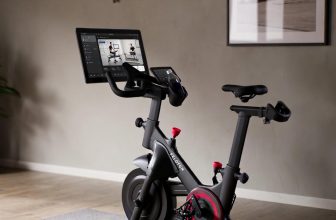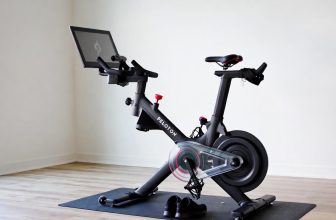Table of Contents
- Does Exercise Bike Help with Knee Pain?
- Understanding Knee Pain and Its Causes
- Benefits of Using an Exercise Bike for Knee Pain
- Low-Impact Exercise Reduces Joint Stress
- Strengthens Supporting Muscles
- Improves Joint Mobility and Flexibility
- Supports Weight Management
- How to Use an Exercise Bike Safely for Knee Pain
- Proper Bike Setup
- Recommended Cycling Routine
- Precautions to Avoid Injury
- Who Can Benefit Most from an Exercise Bike?
- Comparing Exercise Bikes to Other Low-Impact Options
- FAQs About Exercise Bikes and Knee Pain
- Final Thoughts
- About Author
- Mariar Fernandez
As an Amazon Associate, I earn from qualifying purchases.
Does Exercise Bike Help with Knee Pain?
Does Exercise Bike Help with Knee Pain? Yes, an exercise bike can help with knee pain by providing a low-impact workout that strengthens muscles around the knee, improves joint mobility, and reduces stiffness, but results depend on proper use and individual conditions.
Understanding Knee Pain and Its Causes
Knee pain affects millions, with over 25% of adults experiencing chronic knee pain, according to the American Academy of Orthopaedic Surgeons. Common causes include:
- Osteoarthritis: Wear and tear of cartilage, impacting 32.5 million Americans (CDC, 2020).
- Injuries: Meniscus tears or ligament strains, often from sports or accidents.
- Overuse: Repetitive strain from running or high-impact activities.
- Obesity: Excess weight increases knee joint stress, with a 5-10% weight loss reducing pain by up to 50% (Arthritis Foundation).
Exercise bikes offer a low-impact solution to manage knee pain while promoting joint health.
Benefits of Using an Exercise Bike for Knee Pain
Low-Impact Exercise Reduces Joint Stress
Exercise bikes provide smooth, controlled motion, minimizing impact on knees compared to running or jumping. A Journal of Orthopaedic Research study found low-impact cycling reduced knee joint stress by 20-30% compared to treadmill running.
Strengthens Supporting Muscles
Cycling strengthens quadriceps, hamstrings, and calves, which stabilize the knee. Stronger muscles absorb more load, reducing joint strain. A 2019 study in Clinical Biomechanics showed that 8 weeks of cycling increased quadriceps strength by 15% in osteoarthritis patients.
Improves Joint Mobility and Flexibility
Regular cycling enhances synovial fluid circulation, lubricating joints and reducing stiffness. The Arthritis Foundation notes that 30 minutes of cycling 3-5 times weekly can improve knee range of motion by up to 10 degrees.
Supports Weight Management
Cycling burns 200-600 calories per hour, aiding weight loss, which alleviates knee pressure. For every pound lost, knee joint load decreases by 4 pounds during movement (Osteoarthritis and Cartilage Journal).
How to Use an Exercise Bike Safely for Knee Pain
Proper Bike Setup
Incorrect setup can worsen knee pain. Follow these steps:
- Adjust Seat Height: Align the seat so your knee is slightly bent at the pedal’s lowest point.
- Set Handlebar Position: Ensure a comfortable, upright posture to avoid strain.
- Use Proper Resistance: Start with low resistance to prevent overexertion.
Tip: Consult a physical therapist for personalized setup guidance.
Recommended Cycling Routine
- Frequency: 3-5 sessions per week, 20-30 minutes each.
- Intensity: Low to moderate, maintaining a pain-free range.
- Warm-Up/Cool-Down: 5 minutes of light pedaling before and after.
A 2021 Physical Therapy Journal study reported that moderate cycling for 12 weeks reduced knee pain by 35% in osteoarthritis patients.
Precautions to Avoid Injury
- Avoid Overuse: Limit sessions to prevent strain.
- Monitor Pain: Stop if pain increases during cycling.
- Consult a Doctor: Seek medical advice for severe or persistent knee pain.
For detailed setup tips, visit the Arthritis Foundation’s guide on exercise equipment.
Who Can Benefit Most from an Exercise Bike?
Exercise bikes are ideal for:
- Osteoarthritis Patients: Reduces pain and improves function.
- Post-Injury Recovery: Supports rehabilitation without high impact.
- Overweight Individuals: Facilitates weight loss to ease knee stress.
However, those with acute injuries or severe joint damage should consult a doctor before starting.
For more on cycling benefits, check the American Academy of Orthopaedic Surgeons’ exercise recommendations.
Comparing Exercise Bikes to Other Low-Impact Options
| Exercise Type | Knee Impact | Muscle Strengthening | Calorie Burn (per 30 min) | Cost |
|---|---|---|---|---|
| Exercise Bike | Low | High | 150-300 | $100-$1000 |
| Swimming | Very Low | Moderate | 200-400 | Pool access fees |
| Walking | Moderate | Low | 100-200 | Free |
Cycling offers a balance of affordability and effectiveness, making it accessible for home use.
FAQs About Exercise Bikes and Knee Pain
Can an exercise bike worsen knee pain?
If used incorrectly (e.g., wrong seat height or high resistance), it may aggravate pain. Always prioritize proper setup and moderate intensity.
How long should I cycle to see results?
Most studies suggest 8-12 weeks of consistent cycling (3-5 times weekly) for noticeable pain reduction and mobility improvement.
Are recumbent bikes better for knee pain?
Recumbent bikes reduce lower back strain and may be more comfortable for severe knee pain, per a Journal of Physical Therapy Science study.
Can I use an exercise bike after knee surgery?
Yes, but only with a doctor’s approval, typically starting with short, low-resistance sessions during rehabilitation.
For further reading, explore the Mayo Clinic’s guide to low-impact exercises.
Final Thoughts
Exercise bikes are a powerful tool for managing knee pain, offering low-impact exercise that strengthens muscles, improves mobility, and supports weight loss. By following proper setup and routines, most individuals can experience significant relief. Always consult a healthcare professional to tailor cycling to your condition. With consistent use, an exercise bike can be a game-changer for knee health.







